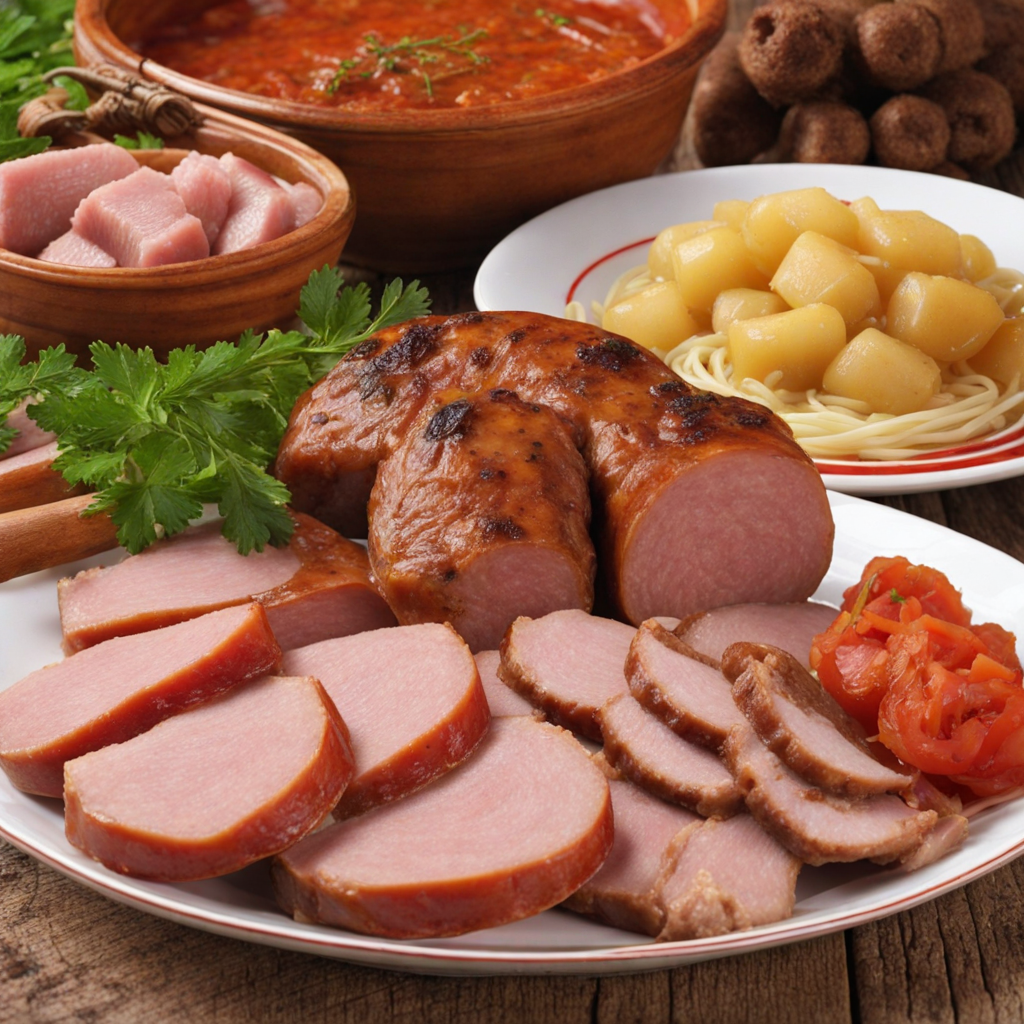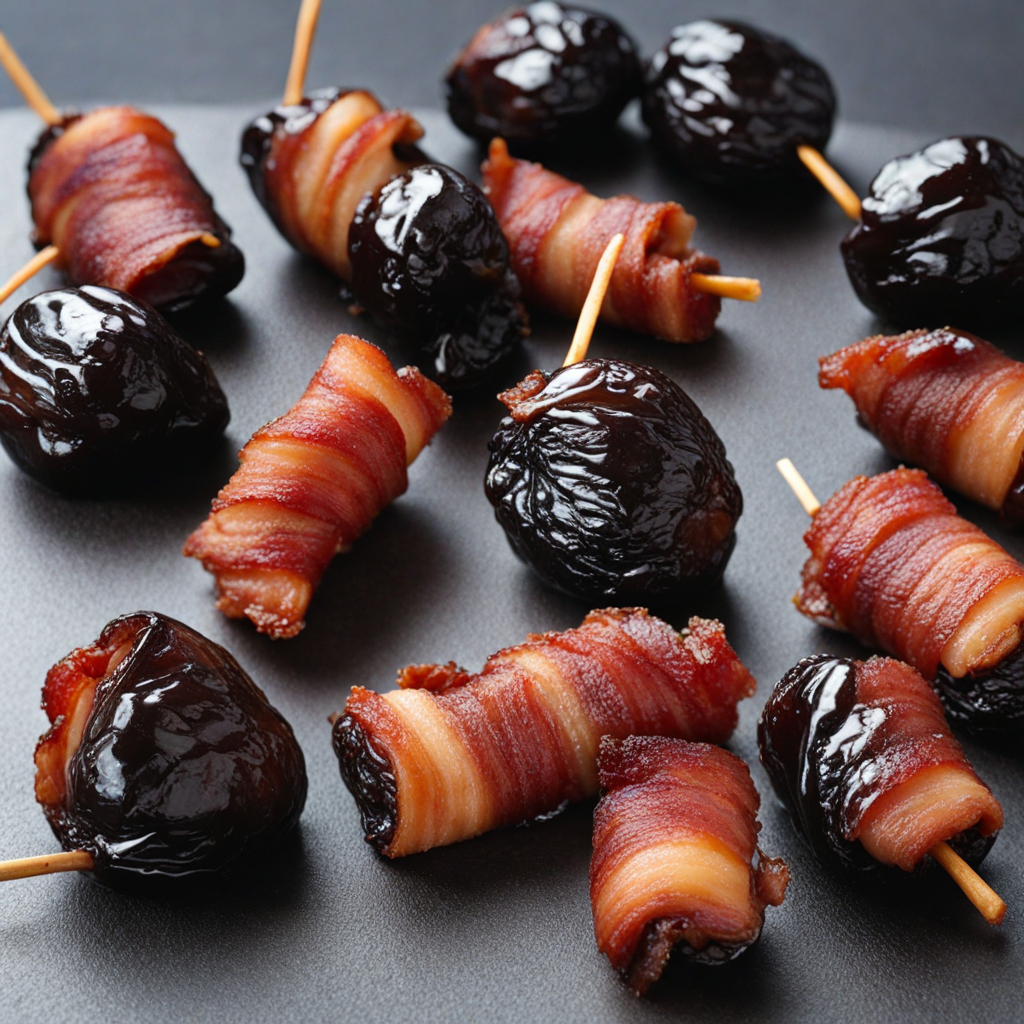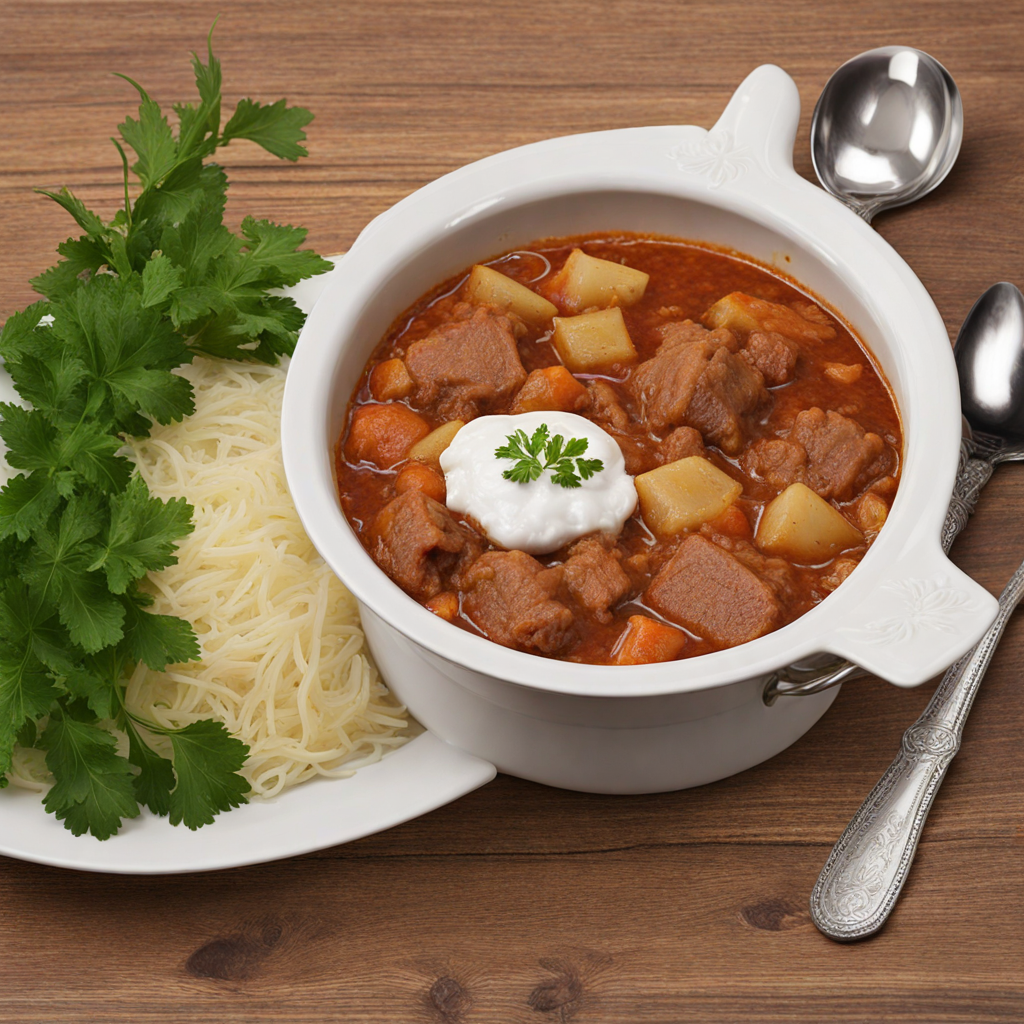Disznótoros
Disznótoros, a traditional Hungarian dish, embodies the rich culinary heritage of the region, particularly celebrated during the winter months. The name translates to "pig slaughter," and it refers to a festive occasion where families and communities come together to process a pig, ensuring that nothing goes to waste. This dish is a delightful amalgamation of various pork products, primarily sausages, blood pudding, and other cured meats, all infused with a blend of spices that highlight the robust flavors of the ingredients. Each bite offers a savory experience, with a perfect balance of herbs like paprika, garlic, and pepper, which are essential to achieving the signature taste of this dish. The preparation of Disznótoros is as much a cultural event as it is a cooking process. The sausage-making itself is an art, often involving a mix of finely minced pork, fat, and seasonings, all carefully stuffed into casings. The end result is a variety of sausages, including the beloved kolbász, which can be smoked or cooked fresh. On the side, you'll find accompanying dishes such as pickled vegetables, hearty bread, and sometimes even sweet pastries, creating a well-rounded meal that showcases the diversity of Hungarian flavors. The communal aspect of the preparation lends a sense of warmth and tradition, making it not just a meal but a celebration of camaraderie and heritage. When served, Disznótoros is often accompanied by a glass of pálinka, a traditional fruit brandy that complements the richness of the pork. Each component of this dish tells a story, from the spices that evoke the natural bounty of Hungary's countryside to the methods passed down through generations. Whether enjoyed at a festive gathering or a cozy family meal, Disznótoros invites you to savor the rustic essence of Hungarian cuisine, merging flavors and traditions that have stood the test of time.
How It Became This Dish
Disznótoros: The Heart of Hungarian Tradition Disznótoros, or "pig slaughter," is more than just a culinary tradition in Hungary; it's a vibrant cultural event that embodies the spirit and resilience of Hungarian rural life. With its roots deeply embedded in the agricultural practices of the Hungarian countryside, disznótoros represents a time-honored ritual that has evolved over centuries, reflecting the socioeconomic and cultural shifts within the nation. #### Origins and Historical Context The practice of disznótoros dates back to ancient times, when communities relied heavily on agriculture and livestock for sustenance. In Hungary, pigs have historically been regarded as a crucial source of meat, particularly in the winter months when food preservation was essential. The act of slaughtering a pig was not merely a necessity for survival but also a communal event that fostered social bonds and reinforced family ties. Traditionally, disznótoros would occur in late autumn or early winter, coinciding with the end of the harvest season. This timing was strategic; it allowed families to utilize the leftover grain and vegetable scraps to feed their pigs while ensuring that the meat could be preserved through smoking, curing, or salting. The practice became a communal affair, often involving neighbors and extended family, who would gather to assist in the process. This collaborative spirit forged a sense of community, making disznótoros not just about food but also about relationships and shared experiences. #### Rituals and Practices The disznótoros ritual typically begins early in the morning, with the pig being slaughtered, a process that is carried out with great care and respect. The meat is then divided into various cuts, each destined for specific preparation methods. The most popular dishes that emerge from disznótoros include kolbász (sausage), szalonna (bacon), and sonka (ham). Each of these has its distinct preparation style, often infused with spices such as paprika, garlic, and black pepper, reflecting the bold flavors characteristic of Hungarian cuisine. Among the most celebrated products of disznótoros is the leberkas, a type of meatloaf made from a mixture of minced pork and beef, seasoned with herbs and spices. Additionally, töltött káposzta (stuffed cabbage) made with leftover meats and rice often finds its way onto the festive table. The process of making kolbász is particularly noteworthy: seasoned ground meat is stuffed into casings and then smoked, producing a flavorful sausage that is a staple in both homes and markets across Hungary. Food, of course, is complemented by drink. The disznótoros gathering typically features traditional Hungarian wines and pálinka, a potent fruit brandy, which further strengthens the communal atmosphere. This festival-like setting transforms the act of butchering into a celebration of life, community, and the bounties of the land. #### Cultural Significance Disznótoros holds profound cultural significance in Hungary. It symbolizes not only the agricultural heritage of the nation but also a connection to the land and the cycles of nature. The communal aspect of disznótoros underscores the importance of family and community ties, particularly in rural areas where such traditions remain vibrant. In an age of industrialization and globalization, where food production has often moved away from local practices, disznótoros serves as a reminder of the importance of sustainable and responsible farming. The tradition is deeply rooted in principles of self-sufficiency, resourcefulness, and respect for the animals that provide sustenance. In many ways, it reflects a lifestyle that values hard work, community cooperation, and the celebration of agricultural bounty. Modern Hungary has seen a resurgence of interest in authentic culinary traditions, including disznótoros, as people seek to reconnect with their cultural roots. Festivals celebrating this practice are common, drawing visitors from across the country and beyond. These events showcase not only the culinary aspects but also the music, dance, and folklore associated with disznótoros, further enriching the experience. #### Evolution and Adaptation Over time, disznótoros has adapted to changing social and economic conditions. With urbanization, fewer people in Hungary are involved in traditional farming practices, leading to a decline in the number of households that engage in disznótoros. However, innovative chefs and food enthusiasts have begun to revive and reinterpret this tradition, blending it with modern culinary techniques and presentations. Restaurants and culinary schools have embraced disznótoros, offering workshops and classes on the art of sausage-making and traditional Hungarian charcuterie. This has sparked a greater appreciation for local ingredients and artisanal food production, encouraging a new generation to explore their heritage through culinary practices. Moreover, the rise of the "farm-to-table" movement has paralleled the resurgence of disznótoros, highlighting the importance of knowing where one’s food comes from. Chefs are increasingly sourcing their meats and produce from local farms, emphasizing transparency and sustainability. In this context, disznótoros stands as a model of traditional food practices that can inspire modern culinary philosophies. #### Conclusion Disznótoros is more than just a method of preparing food; it is a celebration of Hungarian culture, community, and history. As it evolves and adapts to modern contexts, it continues to serve as a powerful reminder of the importance of tradition, sustainability, and the connections between people and the land. With each pig that is slaughtered, and each sausage that is made, the spirit of disznótoros endures, weaving together the past and present in a tapestry of flavors, stories, and communal bonds that define Hungarian identity. In celebrating disznótoros, we not only honor a culinary tradition but also the values of community, respect for nature, and the richness of a culture that has withstood the tests of time. As Hungarians continue to gather around tables filled with the fruits of disznótoros, they reinforce the idea that food is not merely sustenance; it is a cultural narrative, a shared history, and a celebration of life itself.
You may like
Discover local flavors from Hungary







